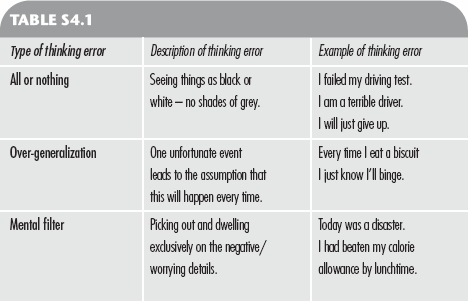
In Step 3 we saw how easy it is to slip into repetitive patterns of thinking that are all too often negative and based on interpretations rather than fact. These negative automatic thoughts can be categorized into various types of thinking errors. The table below lists the most common types, with a description and example of each.
If we look again at the excerpt from the cognitive therapy diary of the student mentioned in the last Step, we can now add an extra column to the table to identify the thinking errors involved.
With the help of this example, now look back over any negative automatic thoughts that you have recorded and try to decide if these thoughts contain any of the types of thinking errors listed in the table. Write down beside the negative automatic thought which thinking error it contains. Sometimes a thought will fit into more than one category, so don’t worry if you can’t find just one slot for each of your thoughts.
You will probably find that there are certain patterns of errors you keep on making; in other words, you will have your individual repertoire of habitual thinking errors.
Do not try to think of rational responses to your thinking errors until you have learned to identify the type of error first. This stage is important; in order for rational responses to be effective, it is necessary to understand the negative bias or erroneous thinking that you are trying to challenge.